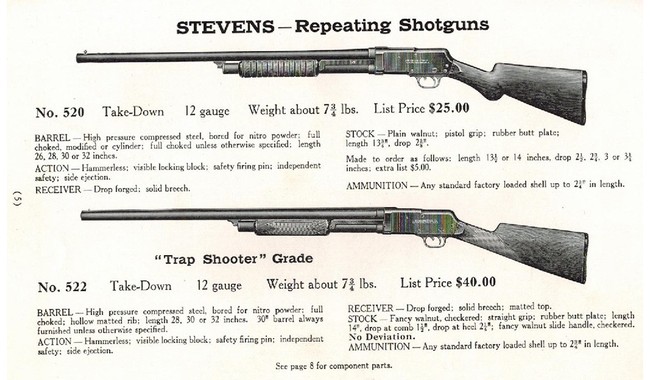John Browning’s Other Shotgun – the Stevens 520/620
In early 1946, my Dad was finally getting ready to head home after his Army Air Forces service. He was in Victorville, California, having been sent there to check out in B-29s just before V-J Day. Once Japan had surrendered Dad’s trip to the Marianas was canceled, but the Army wasn’t ready to send him home yet. With nothing to do, Dad volunteered to help another officer run the trap and skeet ranges.
As Dad described it, the range complex was meant to provide some recreation for service members coming back from the Pacific, but understandably, most of those fellows had done enough shooting recently to last them a while. So Dad and the other officer shot trap and skeet. A lot of trap and skeet. Dad got to the point where he was knocking out pretty consistent 25-straight trap scores with the range’s battered old Model 12s and Remington Model 11s. Finally, the Army said Dad could go home, an offer he grabbed, since he had a girl (who would become my Mom) waiting, he jumped at the chance. The Army told him he could ship one standard Army footlocker at government expense. Dad’s uniforms fit in a suitcase, so he took a footlocker to the range, filled it with 12-gauge trap loads, and shipped it home – on Uncle Sam.
So Dad got home with a suitcase full of Army officers’ uniforms and a footlocker full of 12-gauge shells. When November came around, Dad wanted to go pheasant hunting; he had a lot of ammo but no gun, so he went to the Sears, Roebucks store in Waterloo and bought a 12-gauge pump shotgun – it was marked as a “J.C. Higgins 102.25,” but what it was, was a Stevens 520A – a good, solid, steel-frame takedown pump shotgun, and a lesser-known product of the mind of the Leonardo DaVinci of firearms, John Moses Browning. Dad got a lot of use out of that old gun; at one point in the early ‘70s, he sent it up to the old Herter’s company in Waseca, Minnesota, to have a collet-type poly choke installed, which the old gun still sports to this day.
The story of this gun is an interesting one that spans some decades.
Browning and Stevens
Stevens is probably best known for being the creators of the .22 Long Rifle cartridge and the Stevens Favorite single-shot rifle that is still beloved by collectors today. Founded by Joshua Stevens in 1864, the company has long been known for inexpensive but quality firearms, simple but reliable. They produced a lot of guns as private-label items, like Dad’s J.C. Higgins shotgun; Montgomery Wards, if memory serves, also sold a private-label version of the Stevens 520 and 620 pump guns.
Our story for today begins in 1903 when John Browning applied for a patent for a pump-action shotgun with a new design for the takedown feature and a new locking breech block. That patent was approved in 1905, and the Maestro sold it to the Stevens Arms Company in Chicopee Falls, Massachusetts, who started manufacturing what they called the Model 520 in 1909.
See Related: Sunday Gun Day XXXVIII - The Browning Museum, Ogden, Utah
The Stevens 520
The new 520 was, to my eyes at least, a little awkward looking. It had the characteristic Browning “humpback” receiver, but the initial 520 had a sort of double humpback. The 520 was first offered for sale in the 1909 Sears & Roebuck catalog, and of course, in those innocent times, one could get one from Sears by mail order. In 1920, Stevens was purchased by the Savage Arms company, which made some design changes to the 520, including an improved safety and slide release. In 1925, Savage/Stevens started making private-label versions of the 520, specifically the Ranger Model 20 for Sears & Roebuck and the Western Field Model 30 for Montgomery Wards.
The takedown feature on these guns is actually an improvement, if you ask me, on the one the Maestro designed into the Model 1897 Winchester and which was carried over into the immortal Model 12. In the Stevens, one need only open the slide, turn the magazine tube counter-clockwise until a tab on the barrel/magazine tube assembly disengages from a slot in the receiver, and then the entire barrel and magazine slide downward, disengaging from the receiver and allowing the gun to be more easily packed away.
 One Model 520 was built in “trench gun” configuration in 1918 and was offered to the US military for the Great War, but the 520 at that time wasn’t blowing up any skirts at the War Department, so our boys Over There carried the 1897 Winchester instead.
One Model 520 was built in “trench gun” configuration in 1918 and was offered to the US military for the Great War, but the 520 at that time wasn’t blowing up any skirts at the War Department, so our boys Over There carried the 1897 Winchester instead.
See Related: Sunday Gun Day XL: The Legend of the Trench Gun
Stevens offered a few variations on the basic 520, including a trap gun and several grades of guns with increasingly fancy engraving and stock quality. The gun was only available as a 12 gauge until 1928 when the company brought out a 16-gauge version, followed by a 20 gauge in 1930.
Then, in 1940, the 520 was redesigned and the new version was dubbed the 520A.
The Stevens 520A, and Wartime Service
The 520A was similar to the 520 but lost the double-hump for a more typically Browning single-hump. The trigger-guard safety was replaced by a sliding safety on the tang, and the trigger mechanism was improved, mostly with the replacement of flat springs for coil springs.
The 520A was sold under the Riverside brand as the Model 520, and while it never appeared in the Savage/Stevens catalog, it was listed by Sears as the 102.25 and by Montgomery Wards as (still) the Western Field Model 30.
When 1941 rolled around the Stevens 520A was put in uniform. The wartime version wore the Ordnance Department’s “bomb” marking and had an 18” barrel, a heat shield, and a bayonet lug. The gun’s slam-fire capability made it a nasty thing to have in a trench or close urban or jungle fighting. Civilian production of the gun stopped while Savage/Stevens was involved with war production; they made M1 rifles as well, among other things – but production resumed in 1946 and continued until 1948. It was one of these post-war 520As that Dad bought.
The Stevens 620
Introduced in 1927, the 620 was little more than a streamlined version of the 520. The 620 eschewed the Browning humpback and had a rounded receiver in the style of the Winchester Model 12 and the Remington 870. Otherwise, there were few functional differences from the 520A.
Both the 520A and the 620 were manufactured as trench and riot guns for the military. The Stevens 520 and 620 military livery guns served, at least, into the Vietnam era. Original military examples of the 520A, unlike the generic guns, command a fancy price on the online market, with good examples going for $2,500-3,500, easily. But the regular-grade guns can be had for a pretty low price - I've seen Model 520s going at online auctions for a couple hundred bucks.
Today
Sadly, none of these fine old guns, the 520, 520A, or 620, command a lot of money on the online auction market - on the other hand, there aren't many available. People who have them seem to be hanging on to them - I know I'm hanging on to mine, but then, it was my Dad's gun, so there's more than a collector's attachment there. These guns are all C&R eligible, so if you’re a licensed collector you can have one shipped directly to you. And they remain, as all of the Maestro’s creations were, a fine piece of work: Rugged, solid, reliable.
I still have my Dad’s old gun. I don’t know how many shells that were fired through that old workhorse over the years, but it was certainly in the thousands. A few years back I took it to the gunsmith school in Denver and had it refurbished; the notch in the action bar that hooks into the bolt carrier was badly worn so they welded in new metal and reground the slot, replaced some screws and pins, and reblued the steel and refinished the fine black walnut stock. It looks as great as it works now, and while it now resides in my son-in-law’s safe in eastern Iowa, it’s still mine; I keep it down there for the odd pheasant-hunting excursion with my son-in-law and his Dad, and the old Stevens will still put down a bird with dispatch.
Everything John Browning ever designed has stood the test of time. If you happen to be in the market for a pump shotgun and want one that is rugged, reliable, and breaks down for easy carriage, you could do a lot worse than one of these lesser-known Brownings, the Stevens 520/620 series. Give them a look.














